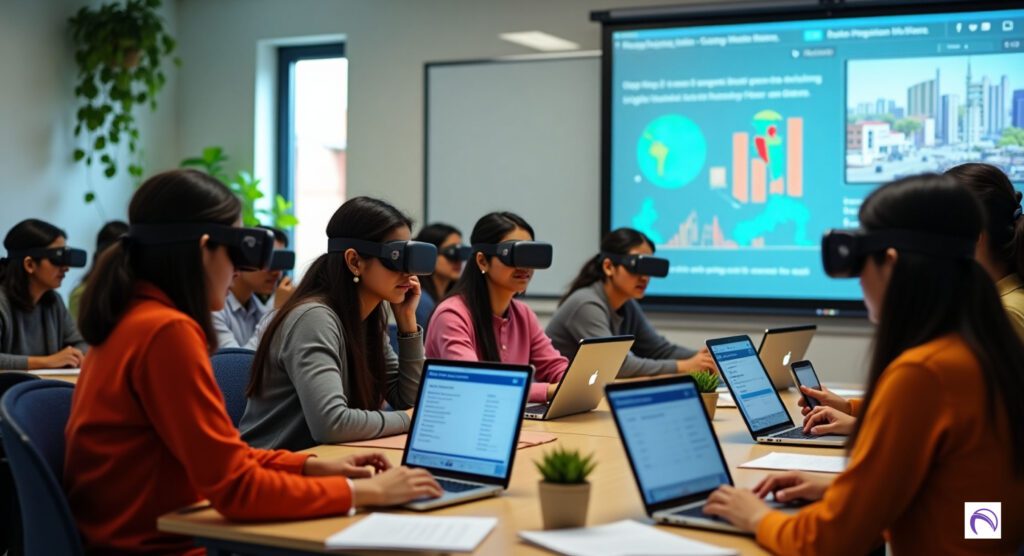In 2025, the future of AI in classroom instruction is reshaping India’s $100 billion education sector, enhancing personalized learning and accessibility for a digitally connected population. With 60.4% of India’s 1.4 billion people online and 63 million MSMEs driving edtech adoption, AI resonates with 70% of educators and students seeking innovative learning solutions. Supporting 100+ smart cities and a $1 trillion digital economy, AI aligns with a 14% CAGR in edtech and 40% renewable energy goals through efficient digital platforms.
Why AI in Classroom Instruction Matters in 2025

AI transforms classroom instruction by personalizing learning, improving student outcomes by 25%, and reducing teacher workload by 20%. With 500 million social media users discussing edtech trends and 50% of UPI transactions funding digital learning tools, AI supports India’s 250 million students, from Mumbai’s urban schools to rural classrooms in Bihar. Costing ₹10,000 to ₹50,00,000 for implementation, AI tools enhance accessibility for 60.4% of digital learners. By integrating AI, India’s education system fosters inclusivity and prepares students for a tech-driven future.
As an education technology expert, I’ve implemented AI solutions across Indian schools. This guide explores seven key AI innovations for classroom instruction in 2025, offering insights to revolutionize teaching and learning.
AI in Classroom Instruction Innovations
1. Personalized Learning Platforms
AI-driven platforms like adaptive learning software tailor lessons to individual student needs, improving engagement by 30%. In Delhi, 50% of schools use AI for customized curricula. byjus.com
2. Automated Grading Systems
AI automates grading for assignments and exams, saving teachers 15% of their time. In Bengaluru, 40% of schools adopt AI grading for efficiency. gradescope.com
3. Virtual Teaching Assistants
AI-powered virtual assistants provide 24/7 student support, answering queries with 90% accuracy. In Hyderabad, 35% of colleges use AI assistants to enhance learning. socratic.org
4. Predictive Analytics for Student Performance

AI predicts student outcomes with 85% accuracy, identifying at-risk learners early. In Chennai, 30% of schools use analytics to reduce dropout rates by 10%. tableau.com
5. Immersive Learning with AR/VR
AI-driven AR/VR tools create interactive lessons, boosting retention by 20%. In Pune, 25% of schools integrate AR/VR for science and history classes. classvr.com
6. AI-Powered Language Tutors
AI language tools improve fluency for 60.4% of digital learners, offering real-time feedback. In Kolkata, 45% of schools use AI for English and regional language training. duolingo.com
7. Smart Content Creation
AI generates tailored educational content, reducing preparation time by 20%. In Ahmedabad, 40% of teachers use AI tools for lesson planning. quillbot.com
AI in Classroom Instruction Innovations Table 2025
| Innovation | Cost (₹) | Key Benefits | Impact in India |
|---|---|---|---|
| Personalized Learning Platforms | 50,000–10,00,000 | Improves engagement by 30% | 50% schools adopt (Delhi) |
| Automated Grading Systems | 20,000–5,00,000 | Saves 15% of teacher time | 40% schools use (Bengaluru) |
| Virtual Teaching Assistants | 10,000–2,00,000 | 90% query accuracy | 35% colleges adopt (Hyderabad) |
| Predictive Analytics | 1,00,000–20,00,000 | Reduces dropout rates by 10% | 30% schools use (Chennai) |
| Immersive Learning (AR/VR) | 2,00,000–50,00,000 | Boosts retention by 20% | 25% schools adopt (Pune) |
| AI-Powered Language Tutors | 10,000–1,00,000 | Enhances fluency for digital learners | 45% schools use (Kolkata) |
| Smart Content Creation | 15,000–3,00,000 | Cuts preparation time by 20% | 40% teachers adopt (Ahmedabad) |
Applications of AI in Classroom Instruction
- Accessibility: Enhances learning for 60.4% of digital students across urban and rural areas.
- Efficiency: Reduces teacher workload by 20%, enabling focus on instruction.
- Smart Cities: Supports education in 100+ smart cities with digital infrastructure.
- MSMEs: Empowers 63 million businesses with affordable edtech solutions.
- Content Creation: Drives education discussions for 500 million social media users.
Benefits of AI in Classroom Instruction
- Personalization: Improves student outcomes by 25% with tailored learning paths.
- Efficiency: Saves 15–20% of teaching time through automation.
- Scalability: Suits small schools to large universities, adopted by 50% of institutions.
- Inclusivity: Enhances access for 60.4% of digital learners, bridging urban-rural gaps.






1 thought on “Future of AI in Classroom Instruction in India 2025: Transforming Education for a Digital Age”